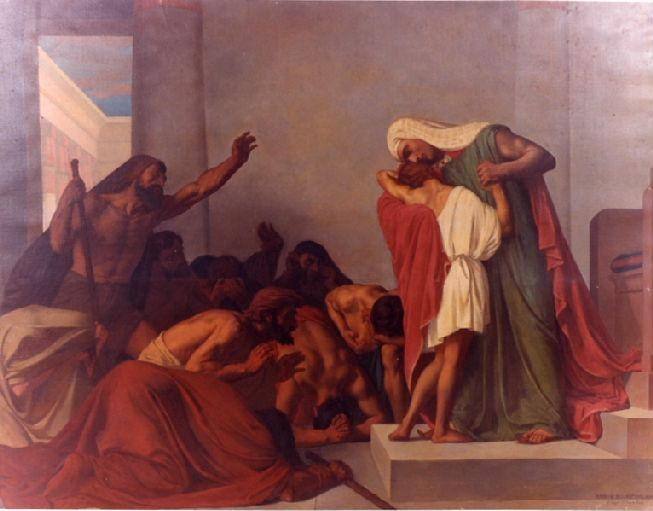
The majority of Christians read the Bible as inspiring spiritual text without too much consideration of the more academic side of biblical interpretation. Thorough Bible readers are at the mercy of textual notes to get whatever benefit is possible from a more academic approach. However, paying more attention to the figurative language in the Bible does not require theology degrees, and it gives the reader an almost supernatural boost in comprehension.
Religious Hermeneutics
Application of figurative language concepts to Bible reading is a form of biblical hermeneutics. Hermeneutics is the science/methodology of interpretation – it is the study of how best to interpret a text. In fact, hermeneutics is an umbrella term for interpretation in all contexts – biblical, religious, philosophical, and other contexts – even non-verbal ones. There is considerable overlap between the terms hermeneutics and exegesis: However, exegesis refers specifically to interpretation itself, while hermeneutics refers more to the way something is interpreted.
Linguistics is the study of language; in the case of the Bible, ancient Hebrew, Aramaic, and Greek come into play. Understanding the vocabulary and sentence structure used in a wider language context is important to getting a sense of what the writer is really saying.
[If you want to better understand the Bible, learn Biblical languages. Read here how you can do this.]
Philology is the comparison of various texts to determine authenticity or origin. Philologists notice and analyze variations in different copies of the same text. Because most biblical texts are taken from ancient writings, this is a very important area of hermeneutics. It is impossible to assess the credibility of biblical sources in the same way we would modern sources; rather, a complex analytical system of discovery, comparison, and consultation is needed for biblical texts to be viewed as credible.
Biblical Hermeneutics
From a hermeneutical point of view, the Bible provides some unique challenges. For one thing, the Bible is actually a relationship between two religions: Christianity is, by definition, a conceptual progression from Judaism. Therefore, the relationship between the Old Testament and the New Testament always has to be taken into account.
All religions have hermeneutic challenges. Talmudical hermeneutics (Judaism) involves determining law from the texts – very much the way a judge might interpret a body of laws as applied to a specific court case. Islamic scholars debate whether the Koran even should be subject to human interpretation. Vedic hermeneutics (Hinduism) involves determining “right living” – the focus of the religion. Buddhism includes exegetical texts as part of its body of religious texts – conveniently, this religion explains itself, but this does not prevent all hermeneutic debate.
In the Bible, there is a literary trend of mundane/earthly details standing in for spiritual/heavenly ideas. This is so commonplace in the Bible that most Christians read it without much thought. However, becoming more mindful of when and how this is being done greatly increases the reader’s appreciation and comprehension.

The Role of Figurative Speech
Figurative speech involves wording that, if interpreted only by definition, would be nonsensical. In contrast, literal meaning arises from a purely logical application of word definitions. Both use and interpretation of figurative language demand a more intuitive, nuanced application of semantics (word choice) – and more imagination.
Why should figurative language be used? Indeed, it is taboo in scientific writing; in science, clarity is key – there should only be debate about the validity of findings, not the meaning behind the scientist’s wording. However, in other types of writing, figurative language helps to engage the emotions and intuition in a way that drives a point home. Sadly, this can also create an almost insurmountable lack of clarity. Scholars debate the meanings behind biblical and other ancient texts to this day.
A common figure of speech in the Bible is the use of symbolic and/or exaggerated wording to emphatically compare or contrast two spiritual entities – quite commonly the good versus the evil, the faithful versus the unfaithful, and love versus selfishness. Furthermore, it is more normal than not to see multiple figures of speech stacked on top of one another: picking apart figures of speech in the Bible is a great way to bring new life to a passage you thought you already understood quite well.
Conveniently, both the Old and New Testaments often provide a literal explanation soon after a densely figurative passage – as when Jesus’ disciples ask for an explanation of his parables or when Joseph and Daniel interpret symbolic dreams. Many biblical figures of speech have leaked into modern English idiom. (Idiom refers to combinations of words that do not literally make sense but are customarily used to express an idea.) For example, calling someone “a wolf in sheep’s clothing” (to suggest that the person seems nice but is really ill-intentioned) comes from Jesus’ description of false prophets in Matthew 7:15.
Figurative Language in the Bible: Seemingly Illogical Sentences
Religious paradox and oxymoron are both seeming departures from logic, but both are completely intentional and serve a purpose. Paradox, in the context of the Bible, is a statement that appears to be a contradiction but, when looked at from a different perspective, it turns out to be true. Therefore, one function of a paradox is to make the reader look at a situation in a novel way. Probably one of the most famous examples is Paul’s “…for whenever I am weak, then I am strong” (2 Corinthians 12:10).
Oxymoron refers to an expression where the component words seem to inherently contradict one another, based on literal definitions. For example, saying that someone is “pretty ugly” could be heard as nonsense, but a native English speaker knows that this is a different use of the word “pretty.” Readers have to rely on Bible notes where instances of oxymoron are used in the Hebrew or Greek texts, since oxymoron will not come through with translation. However, oxymoron indicates cleverness or playfulness on the part of the original writer.
Hyperbole, or exaggerated wording, is used heavily throughout the Bible. Many times, it is used along with other figures of speech. For example, in Genesis 22:17, God says, “I will indeed bless you, and I will make your offspring as numerous as the stars of heaven and as the sand that is on the seashore…” This double hyperbole expresses the vastness and beauty of God’s blessing far more effectively than if God had given an exact number of future descendants.
Most people instantly understand metonymy in biblical passages. Metonymy is the use of a related entity’s name in place of the one actually intended. A common example is the Lord’s invitation to “drink the cup” (as alluded to in 1 Corinthians 11:26 and other places); clearly, Jesus means we are to drink the contents of the cup, not the cup itself. Notice also that the contents of the cup are meant as a symbol, making this is a combination of figurative elements.
Comparisons and Symbols
At heart, most figurative expressions are instances of symbolism. A common use of symbolism in the Bible involves the use of specific numbers in a consistent way throughout both Testaments: 7 suggests wholeness or perfection; 12 suggests a group devoted to God.
These numbers could sometimes be viewed as synecdoche, a specific type of metonymy, where a part of something is used to represent its whole: Aside from a case of 12 individually named people – as the 12 disciples – a nameless group of 12 in the Bible is usually representative of a much larger group. (Note that synecdoche can work the other way around – a whole for part – but this is less common in the Bible.)
No discussion of figurative language would be complete without similes and metaphors. A simile is when something abstract is explicitly compared to something straightforward: For example, in Matthew 10:16 Jesus says, “See, I am sending you [the 12 disciples] out like sheep into the midst of wolves; so be wise as serpents and innocent as doves.” This use of a chain of related similes is sometimes called similitude.
In contrast, metaphor is when something abstract is implicitly compared to something straightforward. For example, in Matthew 7:13, Jesus says, “Enter through the narrow gate; for the gate is wide and the road is easy that leads to destruction…” Jesus makes no explicit comparisons, but it is reasonable to assume that He is not referring to an actual gate or road. However, the metaphor helps get the point across that getting to destruction is easy, and so a person getting to salvation will have a harder life.
Another figurative approach that shows up repeatedly is the anthropomorphism of God. (Anthropomorphism is when a nonhuman entity is described as though a human-being.) God is spoken of as having eyes, hands, and breath – but we know He probably does not literally have these earthly human traits.

The Telling of Stories in the Bible
The main forms of figurative storytelling in the Bible are allegory and parable. A parable is a short, concise story that uses everyday details to impart a spiritual lesson. Despite the symbolic nature of the story, the events themselves are always relatable and believable – parables never use fantastical or bizarre characters or events. Ironically, though, modern readers have trouble understanding biblical parables, since our lives are so different from those of people of the time.
An allegory is a symbolic story with a thorough correlation between the events of the story and the entity actually being described. That said, it generally is better not to overthink allegorical texts – allegories might not correspond with a higher message in absolutely every detail. Some details might have been taken for granted to listeners of the day but sound quite particular to us now.
For example, the Song of Solomon is an allegory that uses love between man and woman as a symbol of the relationship between God and his people. Many of the details of courtship are specific to the time and are only meant to display the devotion, joy, and love the couple have for one another – they are not meant to prescribe specific thoughts or actions.
The line between parable and allegory is somewhat blurred, but parables are usually shorter and more to-the-point; parables are, by definition, stories – whereas allegory is a very broad term for any work of art that symbolizes something else in its components.
You could consider parable a form of allegory, except that parables need not have allegory’s component-by-component correlation with the final message. For example, in Luke 15:4-7, Jesus tells the parable of the lost sheep and concludes “…there will be more joy in heaven over one sinner who repents than over ninety-nine righteous persons who need no repentance.” It is reasonable to assume that the one sinner and the ninety-nine righteous people is not meant to portray an exact ratio – it adds up to one hundred, so it is an intuitive way to demonstrate that God especially values sinners who come back to Him in faith.
Proverbs: a Special Case
Proverbs are a combination of all biblical figures of speech packed into maxims – short, meaningful writings. Proverbs by definition impart some piece of moral wisdom – something they have in common with parables. However, proverbs are not stories, and, consequently, are more direct in their teaching than parables are. For example, “Listen to your father who begot you, and do not despise your mother when she is old” (Proverbs 23:22).
Also unlike parables, proverbs are written with parallelism and balance in their sentence structures; this gives proverbs an almost poetic quality and makes them easy to remember. You can see this element of balance in the proverb above – in how it gives equal attention to both parents. For another example, Proverbs 24:19-20 says, “Do not fret because of evildoers. Do not envy the wicked; for the evil have no future; and the lamp of the wicked will go out.” “Do not” is repeated twice, almost list-like; then, matching reasons are given for both of the “do not” statements.
Figurative Language’s Eternal Value
Figurative language does create complication; people sometimes take allegorical writing far too literally; they have trouble distinguishing the moral from the details. Descriptions of slavery and female submission in the Bible are taken by some people as evidence that God wants these behaviors. In fact, it is more likely that their presence in the Bible was just a product of the time. The object is to find the truth, not get caught up in the details of changing times. Keep this in mind, and you will find that figurative language ultimately gets the Bible’s points across more effectively than any other approach could.